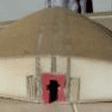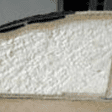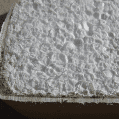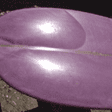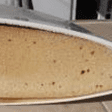Board Construction
written by Eva-M. Hollmann
Once upon a time, in the hayday of the sport, all windsurfing boards were built in a shake-and-bake sort of fashion, using the same sort of materials and processes as kayaks (thick, bounce-proof Polyethylene skins, with the addition of a Urethane foam core). They caught on like wildfire, but had two major disavantages: they were so heavy that you needed the help of your two best friends to move them to the water; and - due to the expensive tooling required for their manufacture - they initially came only in one model : the iconic Windsurfer OneDesign.
As the sport grew and clamored for more variety, local surfboard builders started shaping windsurfing boards, building them the exact same way as surfboards: one at a time, out of "Clark foam", i.e. closed-cell Urethane foam to give them shape, laminated over with layers of fiberglass cloth saturated with Polyester resin, to give them strength. This type of construction, while fairly heavy for a given strength, is still preferred by some for gnarly conditions, like steep chop in heavy winds.
To reduce weight, builders started to use Styrene-based foams for the core, instead of Urethane, at about 1/3 of the weight. Alas, these Styrene-based foams melt when they come in contact with Polyester resin, so more expensive Epoxy resin needs to be used for the laminations of the skins. And as opposed to the closed-cell Urethane foam, most common Styrene-based foams are open-celled, allowing water to be absorbed should the skin be injured. Yikes!
(note: this foam is erroneously called "Styrofoam", which Dow Chemical will emphatically tell you it is NOT. Instead, it is EPS, i.e. "Expanded Poly-Styrene" foam).
To further reduce weight and increase strength, fiberglass was introduced into EPS-cored production boards, with fiberglass laminated using Epoxy resin, then covered with an ASA plastic skin, thermo-formed via very precise, heated stainless steel molds.
Either the skins were layed up into female molds, then clamped shut over an EPS core, leading to vulnerabilities at the seams; or blow-molded EPS cores were laminated with continuous fiberglass skins, then covered with ASA plastic skins.
This construction is still around today and popular with price-point boards and rental companies, due to its hardy nature. It typically has a seam running around its perimeter - though there were exeptions, in devious attempts to hide the plastic nature of the beast.
Various methods are (or should be) employed to make the flat surfaces of these "price-point boards" less prone to caving in: "bulking" materials such as the fibrous "Coremat", various honeycombs, or more recently, woven mats made from Bamboo.
Briefly popular were XTR-cored boards, Styrene-based but closed-cell, i.e. not water-absorbent. Alas, with a considerable percentage of the blowing agent remaining in the foam, these boards had severe delamination problems when they got warm.
For more high-performance boards, Cobra, the go-to board builder in Thailand (and source of 80% of all the Epoxy boards in the world today, be they windsurf, kite, surf, or SUP), introduced sandwich construction as it was already popular with builders of aircraft and high-performance boats at the time. In a sandwich, a relatively light-weight material is used to space high-strength materials, forming a "composite" which is stronger than the sum of its parts. The first boards built in a sandwich construction consisted of a CNC-shaped EPS core, covered by a very light fiberglass skin layed up in Epoxy resin, a thermo-formed 1/8" PVC sheet foam as the "spacer", covered on the exterior with more fiberglass cloth, finished with high-quality Acrylic paints.
This construction is basically still the standard of the industry today, with various modifications, depending on what type of use the board is intended for: for excellent durability, a layer of Pine veneer is often added on deck; for superior stiffness, layers of Carbon are added on deck and often on the bottoms as well; for more environmentally friendly construction, some builders recently substitute an Acrylic-based sheet foam for the sandwich instead of the PVC - though the jury is still out on its suitablity in the long haul. For extreme performance, hybrid fabrics of Carbon, Kevlar and other Aramids are used, albeit at breathtaking cost.
And so it is that you could in the 80s buy a roto-molded longboard for $1150.- weighing 50 lbs, but will today need to shell out more than $2000.- for a short board that weighs 15 lbs. But what a ride!
As the sport grew and clamored for more variety, local surfboard builders started shaping windsurfing boards, building them the exact same way as surfboards: one at a time, out of "Clark foam", i.e. closed-cell Urethane foam to give them shape, laminated over with layers of fiberglass cloth saturated with Polyester resin, to give them strength. This type of construction, while fairly heavy for a given strength, is still preferred by some for gnarly conditions, like steep chop in heavy winds.
To reduce weight, builders started to use Styrene-based foams for the core, instead of Urethane, at about 1/3 of the weight. Alas, these Styrene-based foams melt when they come in contact with Polyester resin, so more expensive Epoxy resin needs to be used for the laminations of the skins. And as opposed to the closed-cell Urethane foam, most common Styrene-based foams are open-celled, allowing water to be absorbed should the skin be injured. Yikes!
(note: this foam is erroneously called "Styrofoam", which Dow Chemical will emphatically tell you it is NOT. Instead, it is EPS, i.e. "Expanded Poly-Styrene" foam).
To further reduce weight and increase strength, fiberglass was introduced into EPS-cored production boards, with fiberglass laminated using Epoxy resin, then covered with an ASA plastic skin, thermo-formed via very precise, heated stainless steel molds.
Either the skins were layed up into female molds, then clamped shut over an EPS core, leading to vulnerabilities at the seams; or blow-molded EPS cores were laminated with continuous fiberglass skins, then covered with ASA plastic skins.
This construction is still around today and popular with price-point boards and rental companies, due to its hardy nature. It typically has a seam running around its perimeter - though there were exeptions, in devious attempts to hide the plastic nature of the beast.
Various methods are (or should be) employed to make the flat surfaces of these "price-point boards" less prone to caving in: "bulking" materials such as the fibrous "Coremat", various honeycombs, or more recently, woven mats made from Bamboo.
Briefly popular were XTR-cored boards, Styrene-based but closed-cell, i.e. not water-absorbent. Alas, with a considerable percentage of the blowing agent remaining in the foam, these boards had severe delamination problems when they got warm.
For more high-performance boards, Cobra, the go-to board builder in Thailand (and source of 80% of all the Epoxy boards in the world today, be they windsurf, kite, surf, or SUP), introduced sandwich construction as it was already popular with builders of aircraft and high-performance boats at the time. In a sandwich, a relatively light-weight material is used to space high-strength materials, forming a "composite" which is stronger than the sum of its parts. The first boards built in a sandwich construction consisted of a CNC-shaped EPS core, covered by a very light fiberglass skin layed up in Epoxy resin, a thermo-formed 1/8" PVC sheet foam as the "spacer", covered on the exterior with more fiberglass cloth, finished with high-quality Acrylic paints.
This construction is basically still the standard of the industry today, with various modifications, depending on what type of use the board is intended for: for excellent durability, a layer of Pine veneer is often added on deck; for superior stiffness, layers of Carbon are added on deck and often on the bottoms as well; for more environmentally friendly construction, some builders recently substitute an Acrylic-based sheet foam for the sandwich instead of the PVC - though the jury is still out on its suitablity in the long haul. For extreme performance, hybrid fabrics of Carbon, Kevlar and other Aramids are used, albeit at breathtaking cost.
And so it is that you could in the 80s buy a roto-molded longboard for $1150.- weighing 50 lbs, but will today need to shell out more than $2000.- for a short board that weighs 15 lbs. But what a ride!
For more articles on board materials, repair, etc, please refer to Eva's website, The Board Lady
